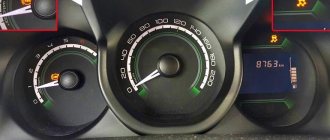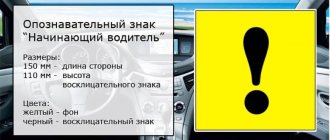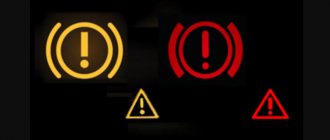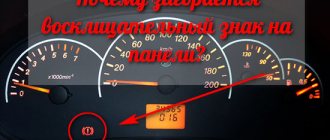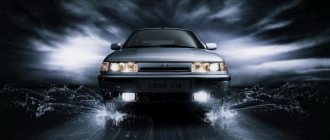1200 rub. for the photo report
We pay for photo reports on car repairs. Earnings from 10,000 rubles/month.
Write:
Some car enthusiasts are afraid that when the ABS light is on, it somehow affects the operation of the braking system as a whole. They urgently begin to scour the entire Internet in search of an answer to why the ABS light is on and what to do. But don’t panic so much, the brakes on your car should be in perfect order, only the anti-lock system will not work , which, in principle, is not critical, although in some emergency situations it helps a lot. To understand the system, I recommend reading about ABS.
The ABS indicator light comes on: what should I do?
All modern vehicles are equipped with an ABS safety braking system, which has a complex design to slow down the vehicle. In European countries, automakers equip all new models with an ABS system, but not every car has a truly practical system.
It works like this: all four wheels of the vehicle are equipped with ABS sensors, which begin to work at the moment of sudden braking. To prevent skidding, the system prevents the wheels from completely locking and gradually reduces their rotation speed.
But this is only possible with high-quality ABS systems, which are installed on vehicle models of the middle and high price categories. As practice shows, the system on budget cars is often a useless addition that does not affect the braking process in any way. In addition, there is another annoying feature of the functioning of ABS on used cars - this is the spontaneous lighting of the ABS and ESP system malfunction indicator on the dashboard. Naturally, such an indication greatly distracts the driver from driving the vehicle, constantly making him think about the occurrence of a serious malfunction.
We will hasten to reassure car owners who are faced with a similar problem. The thing is that the ABS indicator lights up may not at all indicate the presence of problems or malfunctions of the system. Often, the reasons for this are caused by malfunctions of other elements unrelated to the anti-lock braking system.
Don't panic
This is a signal to the driver that a breakdown has occurred in the anti-lock braking system. Many people panic and are afraid to travel. Sometimes the car is dragged on a tow truck or on a cable, and the reason is that the ABS light is on.
No need to worry, because the brakes on the car work. Check to see if the brake fluid has leaked, try pressing the brake pedal. The car is slowing down, only the ABS system has failed. This means that on the way to the repair site you should not brake sharply so that the wheels do not skid.
Reasons why the ABS malfunction indicator turns on spontaneously
In a vehicle with properly functioning components and assemblies, the warning light comes on indicating the wheels are unlocked. This indicates that the system is functioning completely properly. The sensors detected the need to activate the safety braking system and initiated this process, causing the indicator on the dashboard to light up. In this case, the ideal option would be to reduce the impact on the brake pedal to stabilize the vehicle's movement.
If the car has several high-tech safety systems (for example, ABS and ESP), then there is no need to be afraid, since they will do all the work for the driver. Other reasons for the ABS warning light to come on include the following:
- clogged ABS sensors, resulting in a corresponding error (its code can be determined during computer diagnostics);
- incorrect operation of the system caused by the presence of corrosion on the working elements of the sensors;
- failure of the on-board computer caused by the spontaneous activation of various indicators;
- malfunctions of the chassis system elements, during which the positions of the ABS sensors are violated;
- The system fuse has blown.
You shouldn’t rule out the presence of various problems with the car’s electrical network, in particular the failure of some of its consumers, which can also cause the ABS system warning light to turn on erroneously, regardless of whether your car is a one-wheel drive car or a 4WD one.
For example, on some Volkswagen models produced at the end of the 90s, there is one feature associated with the activation of the ABS error warning light if there is a malfunction in other mechanisms.
In such cases, the process of conducting self-diagnosis of the braking control system is only partially justified, since the car owner does not have the necessary diagnostic equipment to correctly determine its malfunction. But the “poke method” is not suitable in this case.
Checking the sensor resistance
Before starting the testing procedure, it is advisable to know the standard resistance value of the ABS sensors installed in your car. This information can be found either on the manufacturer's website or on the Internet. The algorithm for checking the sensor resistance is quite simple:
- We hang the wheel using a jack and remove it.
- We find the ABS sensor and disconnect its connector from the wiring leading to the control unit.
- We switch the multimeter to resistance measurement mode.
- We connect the probes to the contacts of the sensor connector and look at the readings of the device.
- If the ohmmeter shows “0”, this means that there is an open circuit in the sensor coil. This sensor must be replaced. Device readings that exceed the nominal value by 2–3 times also indicate a malfunction of the sensor, namely that its coil is “burnt” and the signals coming from it to the control unit are incorrect.
What to do if the ABS system starts to work incorrectly and the indicator blinks?
This situation is one of the most complex system failures. The thing is that the sensors read incorrect information and transmit it to the control device, which for this reason gives incorrect commands to the actuators. Unfortunately, most vehicle owners, when detecting this malfunction, simply turn off the ABS system, since this is an effective measure to prevent serious consequences while driving. For example, spontaneous activation of the system while driving at a speed of more than 90 km/h can lead to serious damage to the suspension, which will provoke an emergency situation as a result of loss of control over the car. In this case, you need to do this:
- perform system diagnostics at a car service center;
- if the ABS system is installed on a domestic car, it must be disabled;
- it is quite possible that after repairing the ABS, the ECU will need to be reflashed, but this measure is applicable mainly for foreign cars;
- disabling the anti-lock system is not a solution to the problem, since on most vehicles its presence is simply necessary and is determined by the design features of their chassis, body and frame;
- You should not completely rule out the presence of faults in other components of the car that cause interruptions in the operation of the ABS.
It is necessary to remember that only diagnostics using special equipment will help to establish the real reason for the incorrect operation of the anti-lock system, which may lie in the malfunction of its components or other components of the vehicle. Therefore, you should be prepared for anything. But in many cases the problem can be solved quite simply. The cost of restoring the ABS system will depend only on its design and the make of the car. But the need to carry out this work is dictated by the safe operation of automotive equipment, the design of which includes such a system.
Problems caused by the ABS system cannot be called difficult to solve, but in any case they require immediate elimination. As you can see, the banal shutdown of the system, which most car owners consider a panacea in the event of a malfunction, is not always this magic remedy. All that needs to be done is to correctly identify the malfunction and eliminate it, because in most cases, it is not related to the functioning of the anti-lock system.
Like any modern car, Priora is equipped with many devices that make driving more comfortable and safe. Such devices include ABS (Anti-lock Braking System). Like all modern devices, it has its own electronic control unit and a warning light on the instrument panel. And then this lamp lit up. What to do if the ABS fault warning light on a Priora goes off? Where to look? Who should I contact?
In what cases is it necessary to remove the instrument panel?
Disassembly of a Priora order is necessary for tuning or replacing burnt out lamps. The VAZ 2170 is a modern model, so there are not many fastenings on the panel. For disassembly you will need a set of screwdrivers. Don't forget to turn off the minus battery.
The process begins with removing the mounting block. To do this, you need to slide the latches on the fuse cover and then disassemble it;
What is ABS
The anti-lock braking system was developed when it became clear that when the wheels suddenly jam, the car loses stability and is difficult to control. Moreover, the quality of braking did not improve, and the car was pretty much carried off the road. Therefore, a system was developed that, by regulating the pressure in the brake system pipes, allows the wheels to turn slightly. This significantly improves vehicle dynamics, allowing the driver to control the vehicle more confidently. But despite its apparent simplicity, this is a rather complex process that requires the coordinated operation of many mechanisms included in the anti-lock braking system. If any of the components fails, a warning lamp lights up on the instrument panel.
HHC function
Prevents the car from rolling away when starting on an incline. When stopping on an incline greater than 4%, depress the brake pedal with sufficient force to keep the vehicle stationary. When you subsequently release the brake pedal and press the accelerator pedal, the HHC function maintains hydraulic pressure in the brakes until the vehicle starts, but for no more than 2 seconds, which prevents the vehicle from rolling away.
The operation of the HHC is accompanied by a characteristic noise of the actuators. HHC does not operate when the parking brake is applied, the driver's door is open, or the ESC malfunctions.
Let us remind you that other reviews of Lada cars can be found in this category.
Source
ABS device on Priora
Like most modern car systems, ABS is computer controlled. But in addition to the electronic control unit, it also includes several sensors and actuators. The entire system consists of several elements.
- Electronic control unit (ECU).
- Sensors on wheel hubs 4 pcs.
- Brake fluid pressure valves in the system 4 pcs.
- EVN (Electric Return Pump).
- Warning light on the instrument panel.
Despite all its apparent simplicity, this is a rather complex, high-tech system. Each sensor transmits data on the rotation speed of the Priora wheel to the electronic control unit. Based on the data received, the control unit sends a signal to the brake system valve, which, when you press the brake pedal, releasing pressure, prevents the wheels from completely locking and starting an uncontrolled skid of the car.
Anti-lock brake control unit in hydraulic unit
Structurally, on the Priora, the ABS ECU is mounted together with the EWH and valves that regulate the pressure into a single unit - the hydraulic unit. It is located on the front left side member of the vehicle. The hydraulic unit is connected to the entire system by a common wiring harness. It includes pipes for supplying brake fluid to the working cylinders. An EWH is also installed here, increasing the pressure in the system.
Wheel hub sensor
The sensors that supply wheel speed data to the control unit are made on the principle of a Hall sensor. By the way, most rotation sensors use exactly this principle: changing the voltage on the semiconductor of the sensor, depending on the passage of a control point on the rotating disk near it. It is in correlation with the signals from the ABS sensors that the control unit manipulates the valves.
ABS malfunction warning lamp on the Priora instrument panel
What Priora drivers talk about – “the ABS sensor has come on” – is in fact a warning lamp for the serviceability of the anti-lock system. When the ignition is turned on, the orange “ABS” inscription will light up on the dashboard for about three seconds. If the system is working properly, then after three to four seconds the light will go out. In general, the principle of signaling from the “ABS sensor” is the same as from the warning lamp of the main ECU of the car, the well-known “check anger”.
Lada Granta Red Luxury Mechanics › Logbook › Granta and ABS - a surprisingly successful tandem
The brakes themselves on the Grant are ordinary; there aren’t enough stars in the sky. At reasonable speeds they are quite effective, especially on good tires.
But what is quite above average on Grant is ABS. What is ABS anyway? This is a system that, when the brakes are fully applied, seeks a balance between efficiency and controllability. This is how all ABS work, but the details are very important.
You can't comprehend the details without a glass. I'll try to explain it on my fingers)).
What types of ABS are there? Three types - 4s/2m, 4s/3m and 4s/4m. It is likely that the first two types of ABS were used previously, although I have not studied the issue and I won’t lie. I will only talk about four-modulator ABS.
ABS is a blessing. To understand this fact, I recommend taking a ride in FF2 or Logan in trim levels without ABS. There is a pressure limiting valve in the rear axle (much simpler and more reliable than the VAZ regulator), but once and for all configured in such a way that it actually deprives this axle of brakes.
For those who like exact numbers, about 50 kg of force on the rear alone is allowed. While on wet asphalt, for example, you can realize at least 200 kg. This is all done so that the rear will not be blocked before the front at all and on any surface, including the Olympic bobsleigh track.
On cars with ABS, the problem of advanced locking of the rear axle is not so acute, although, contrary to the opinion of many, it still exists. This is true, by the way.
Modern ABS 4S/4M is a subtle and vicious thing. You can configure it so that each wheel will implement the maximum possible braking force at a given time.
It's not hard to see what this will lead to in mixed doubles. Let's say the left wheels are driving on dry asphalt, and the right wheels are driving on the icy side of the road.
And then I had to brake sharply. At a minimum, there will be a sharp departure from the course towards the wheels with more grip (towards the oncoming lane). Or even a simple and vulgar spread with a flip and/or other goodies.
Tuning for a “weak” wheel is also not the optimal solution, because then the braking efficiency drops significantly.
Therefore, they achieve some average, optimal, compromise response. Due to the fact that finding this compromise is difficult, expensive, requiring roads, machine hours and very skilled man hours, it has become fashionable to do most of the work on the computer. The result is a little predictable.
About a year ago, there was a series of articles in the AR about severe bugs in the ABS operation of Polo sedans and Tiguans. There, in certain circumstances, the ABS began to think that there was some kind of crap under the wheels, such as ice, and the brakes disappeared almost completely. www.autoreview.ru/_archiv…_ID=69757&SECTION_ID=1991 www.autoreview.ru/_archiv…ID=123939&SECTION_ID=6991 www.autoreview.ru/_archiv…ID=130174&SECTION_ID=7344 www.autoreview.ru/_archiv…ID=128368&SECTION_ID =7279 As for our Soviet cars, due to poverty, we have not yet learned how to properly work on computers and do a lot of things the old fashioned way, on the road.
The result, I admit, is worth it. ABS Grants, if not the ideal of such a system, are then a very close approximation to such an ideal. Nothing can turn her away from the true path - not a mix, not a turn, not a bumpy road. It works late, allows the wheels to slide a lot, and doesn’t seem to be prone to “hanging” when the brakes are released. In the debate between braking and handling, efficiency clearly wins. This makes me very happy.
Even more gratifying is that Granta happily escaped the Nigerian problems from the links above.
It is clear that with such a balance, ABS in the direction of brake efficiency, on mixed doubles, pulls quite a bit to the side. But if there is an electric steering wheel and the driver is willing to not count crows, everything is within the limits of the rules and common sense.
And the fact that it will be difficult to drive around an obstacle on bare ice with such ABS is right; if you don’t jerk around the steering wheel on black ice, less people around you will suffer.))
Source
Anti-lock braking system malfunctions
All Priora ABS malfunctions can be divided into two categories. Malfunctions of the electronic part and malfunctions in the field of fluid mechanics. That's how they should be considered.
Electronic failures
This is a failure of electronics-related components:
- breaks in the electrical wiring harness;
- failure of rotation speed sensors;
- break or short circuit of the control valve activation coil;
- failure of the return pump electric motor;
- valve activation relay failure;
- program failure, or failure of the ABS control unit.
ABS malfunctions in the field of fluid mechanics
In this case, the most typical failures are leakage of oil seals in various connections and assemblies. Deterioration of working surfaces on disks, and as a result, a change in the distance between the sensor and the readable surface. System valves jamming. Clogging of hydraulic drive pipes and breakdown of the working part of the return pump.
ABS Lada Vesta error codes and their interpretation
Diagnosing ABS yourself is a rather difficult task if you do not have diagnostic equipment (cable, laptop, and software). If you have the ability to read errors, then by comparing their codes with the description, you can much faster determine the cause of the malfunction. The following are the errors that “light up” the anti-lock braking system malfunction light:
Thanks for subscribing!
- U0121 - no data from the ABS system controller
- U0122 - no data from ESP system controller
- U0415 - incorrect data from the ABS system controller
- U0416 - Invalid data from the ESP system controller
In most cases, the absence of data from the controller indicates a malfunction. If the diagnostics indicate errors U0415 or U0416, then there is a high probability of sensor malfunction or damaged wires. Also, do not forget that with different tire pressures, the control system may receive incorrect data from the controller and indicate the last two errors.
ABS fault detection
The serviceability of the ABS system in the Priora, like in any car, is a very important issue. It is very convenient that the slightest malfunction in its operation will immediately be reflected on the dashboard. The ABS warning light will come on or it will not go out after the required time after turning on the ignition.
There's no need to think twice about it. You urgently need to go for computer diagnostics to a decent service station. Modern Priora ABS ECUs have access to a diagnostic connector. They are perfectly diagnosed by both portable portable scanners and stationary motor testers. Since all ABS electronics are very closely connected with the mechanical part, most breakdowns in this area can be determined by an experienced diagnostician by scanning the ECU.
For example, the operating valve is jammed in one of the directions. What happens: the coil, figuratively speaking, tries to influence him, but he doesn’t move. The computer, noticing a load violation in the circuit, will immediately give a signal. The “ABS sensor” will light up. When connected, the technician will see the direction that needs to be looked at and quickly fix the problem.
Don't panic
This is a signal to the driver that a breakdown has occurred in the anti-lock braking system. Many people panic and are afraid to travel. Sometimes the car is dragged on a tow truck or on a cable, and the reason is that the ABS light is on.
No need to worry, because the brakes on the car work. Check to see if the brake fluid has leaked, try pressing the brake pedal. The car is slowing down, only the ABS system has failed. This means that on the way to the repair site you should not brake sharply so that the wheels do not skid.
What to do if the ABS light is on?
It is worth noting that the system works normally if the ABS icon lights up when the ignition is turned on and goes out after a couple of seconds. The first thing to do if the ABS light is constantly on is to check the fuse for this system, and also inspect the wheel sensors.
Quite often, the sensor connector on the hub either oxidizes or the wires fray. And if the ABS icon is on after replacing the pads or hub, then the first logical thought is that you forgot to connect the sensor connector . The presence of dirt on the sensor also causes the indicator to light up.
Quite often, car owners may be frightened by the appearance of an orange ABS icon after a good slip. In this case, you shouldn’t bother at all: brake sharply a couple of times and everything will go away on its own - the control unit’s normal reaction to such a situation. When the ABS light does not light up constantly , but periodically, then you need to inspect all the contacts, and most likely, the cause of the warning light can be quickly found and eliminated.
HOW TO IMPROVE THE LADA DESIGN
To protect the wiring harness from the environment, you can use a D-shaped seal. We lay the wires in it and wrap it with electrical tape. We put everything in the corrugation. We glue the cover covering the ABS sensor connector around the perimeter with the same sealant. This will prevent moisture and dirt from entering the area where the sensor and connector are located.
Attention! If the ABS fails, the brakes remain operational, but the braking efficiency is reduced, which is especially dangerous on some surfaces.
Causes of ABS error
The main possible reasons for a constantly burning ABS light on the dashboard:
- the contact in the connection connector has disappeared;
- loss of communication with one of the sensors (possibly a wire break);
- The ABS sensor has failed (the sensor needs to be checked and then replaced);
- the crown on the hub is damaged;
- The ABS control units have failed.
After inspection and, it would seem, elimination of the cause, it is very easy to check the operation of the ABS; you just need to accelerate to 40 km and brake sharply - the vibration of the pedal will make itself felt and the icon will go out.
If a simple inspection for damage in the sensor circuit to the unit does not reveal anything, then diagnostics will be needed to determine the specific error code for the anti-lock brake system. On cars where an on-board computer is installed, this task is simplified; you just need to clearly understand the decoding of the code and where the problem could arise.
Ways to check functionality
To determine the condition of a part, we will perform a series of steps to diagnose it, moving from simple to complex:
- Let's check the fuses by opening the unit (inside the passenger compartment or in the engine compartment) and inspecting the corresponding elements (indicated in the repair/operation instructions). If a burnt component is found, we will replace it with a new one.
- Let's inspect and check:
- integrity of connectors;
- wiring for abrasions that increase the risk of a short circuit;
- contamination of the part, possible external mechanical damage;
- fixation and connection to ground of the sensor itself.
If the listed measures do not help to identify a device malfunction, it will have to be checked using instruments - a tester (multimeter) or an oscilloscope.
Tester (multimeter)
This method of diagnosing the sensor will require a tester (multimeter), instructions for operating and repairing the car, as well as PIN - wiring with special connectors.
The device combines the functions of an ohmmeter, ammeter and voltmeter
Tester (multimeter) is a device for measuring electric current parameters, combining the functions of a voltmeter, ammeter and ohmmeter. There are analog and digital device models.
To obtain complete information about the performance of the ABS sensor, you need to measure the resistance in the device circuit:
- We lift the car with a jack or hang it on a lift.
- Remove the wheel if it prevents access to the device.
- Remove the cover of the system control unit and disconnect the controller connectors.
- We connect the PIN to the multimeter and the contact socket of the sensor (the connectors for the rear wheel sensors are located inside the cabin, under the seats).
We connect the PIN to the tester and the contact socket of the sensor
The device readings must correspond to the data specified in the repair and operation manual for a particular vehicle. If the device resistance:
- below the minimum threshold - the sensor is faulty;
- approaches zero - short circuit;
- unstable (jumping) at the moment of twitching of the wire - a violation of contact inside the wiring;
- infinity or no readings - wire break.
Attention! The resistance of the ABS sensors on the front and rear axles is different. The operating parameters of the devices are 1–1.3 kOhm in the first case and 1.8–2.3 kOhm in the second.
Video “Diagnostics of the ABS sensor”
How to check using an oscilloscope (with connection diagram)
In addition to self-diagnosis of the sensor with a tester (multimeter), it can be checked using a more complex device - an oscilloscope.
